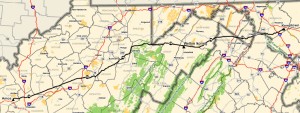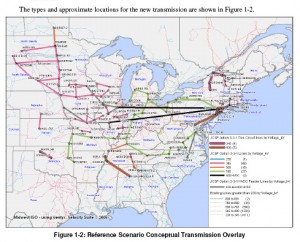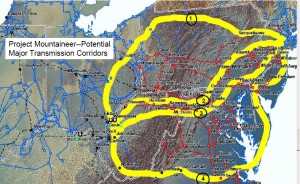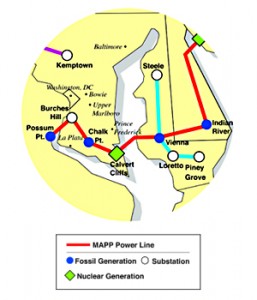US Supremes Weigh in on Electric Market
April 19th, 2016
Here’s an interesting case (oh, how I hate that word “interesting”). It’s about whether a state can offer “incentives” over and above FERC wholesale electric rates that would incentivize construction of new in-state generation. US SCt says NO! The states can only regulate retail rates.
This is a case regarding Maryland “incentives” and PJM, but it’s applicable to our good friends at MISO too.
So do tell, what does this mean for FERC set rates of recovery and cost allocation for all this transmission to enable the wholesale market? What happens when FERC rates stick their nose under the tent in state rate proceedings, i.e., Schedule 26A covering return and cost allocation for these big transmission projects we know and love? From what I can see of Schedule 26A, they’re allocating a “retail share” and, well, what business does FERC, via MISO (in this area), have with retail rates?
Schedule 26A – Indicative Rate Charges MISO (last updated 3/31/2016)
Look at all the ways we’re charged for transmission:
Rough path for PATH
December 11th, 2009
Difficulties are growing for “backbone” transmission for coal in the east. Not long ago, Virginia staff had asked the Commission to deny the PATH proposal. Now, after the hearing ended, after reviewing testimony, staff has again recommended the petition be denied. This is the project where Maryland tossed it out because the applicant was not a public service corporations. If one end of the project is taken out, it’s a project going nowhere.
West Virginia declined to dismiss the application, and instead has taken action, or taken inaction:
Now it’s time for Virginia’s reality orientation.
Va. staff again recommends denial of PATH project
Originally published December 11, 2009
By Ed Waters Jr.
News-Post Staff“The public regulatory review process in Virginia is extremely thorough and has a long way to go. The PATH evidentiary hearings before the Virginia State Corporation Commission are scheduled to begin in Richmond, Va., on Jan. 19, 2010, and are expected to last about two weeks,” Meyers said.
Read the rest of this entry »
Offshore transmission, NOT transmission from Midwest
December 6th, 2009
By standing up for offshore transmission for wind, Delaware’s Gov. Jack Markell stands up to Midwest coal!
The Mid-Atlantic states have been standing up and opposing transmission from the Midwest. They’ve gone on record in a number of venues, and in their opposition are citing Midwest transmission promoters’ disregard for eastern renewable efforts, that xmsn may well not be an economical way to get power to the east, and that THEY KNOW THAT MIDWEST TRANSMISSION PLANS INHERENTLY ARE ABOUT COAL. The plan they’re referring to is a massive transmission buildout known as JCSP, and it also applies to the big PJM buildout that includes the PA-NJ Susquehanna-Roseland transmission line that was the subject of a hearing last month.
Here’s JCSP (Joint Coordinated System Plan) note their site now talks about wind — but look where the transmission starts, DUH! The coal fields of the Dakotas:
Gotta give them, Delaware, Maryland and Virginia, a lot of credit for recognizing and stating what Midwest states have been unwilling to admit.
That said, here’s what Mid-Atlantic states are doing — they’re banding together to propose offshore transmission. If it’s underwater offshore transmission, that’s an idea that’s hard not to like. But I’ll bet it throws PJM for a loop, what with all their “backbone” transmission schemes, a la Project Mountaineer, that are in the works:
The FERC birth of Project Mountaineer:
And you can see that those lines in play now, PJM’s “backbone” transmission projects like Susquehanna-Roseland (NE part of Project Mountaineer Line 1) and MAPP (NE part of Project Mountaineer Line 4) are part of the plan… the big transmission plan that does not work for the east coast.
Here’s the Memorandum of Understanding between Delaware, Maryland and Virginia:
And recently, Gov. Jack Markell addressed these issues before American Wind Energy Association’s offshore windfest — but given the PJM big-transmission-projects-from-hell are referred to as “backbone” projects, I wish they’d find another term:
Delaware energy: ‘Backbone’ power line pushed for wind farms
By AARON NATHANS
The News JournalGov. Jack Markell broached the subject this week in his address to the American Wind Energy Association’s offshore wind workshop, the industry event of the year on this side of the Atlantic. Markell signed onto letters the governors sent to members of Congress this summer, and the Federal Energy Regulatory Commission last month.
“Let’s have the conversation,” O’Mara said. “It’s extremely worthy of further study.”
“It obviously won’t happen in the absence of federal leadership,” he said.
Fishermen’s Energy President Daniel Cohen said it’s a good idea, but “it’s another moving part.”
The benefits of building lines transmitting wind power from the Midwest are less certain, he said.
“It will be difficult to get progress in this area until there are clear national goals,” he said.
Note that “cost allocation” is raised. Since the 7th Circuit decision tossing out FERC approval of PJM’s transmission cost allocation dream/nightmare, all transmission projects 500kV and over based on that cost allocation scheme are in limbo.
So as noted, who pays, and submarine transmission is EXPENSIVE, is THE big issue now. It’s the big issue for land transmission, it’s the big issue for offshore transmission, and, given the uncertainty since the 7th Circuit decision, maybe some of the sturm and drang could be circumvented if it’s designed at 345kV or below, and uses the “benefactor pays” theory. We shall see…
Transmission – Mid-Atlantic Power Pathway
February 2nd, 2009
Delmarva Power has been hosting meetings about its proposed Mid-Atlantic Power Pathway. The next meeting is:
Wednesday, February 4 @ 6 p.m.
Millsboro Civic Center
322 Wilson Highway
This is an electrical superhighway through Delaware, the map makes that much clear.
What’s interesting is that Rep. Tom Carper seems to be taking an enlightened and informed position on this:
Today, there’s a long piece in the News Journal about it, with the above quote from Carper:
Power-line plan stirs environment fears
Bluewater Wind hails pathway for clean energy






